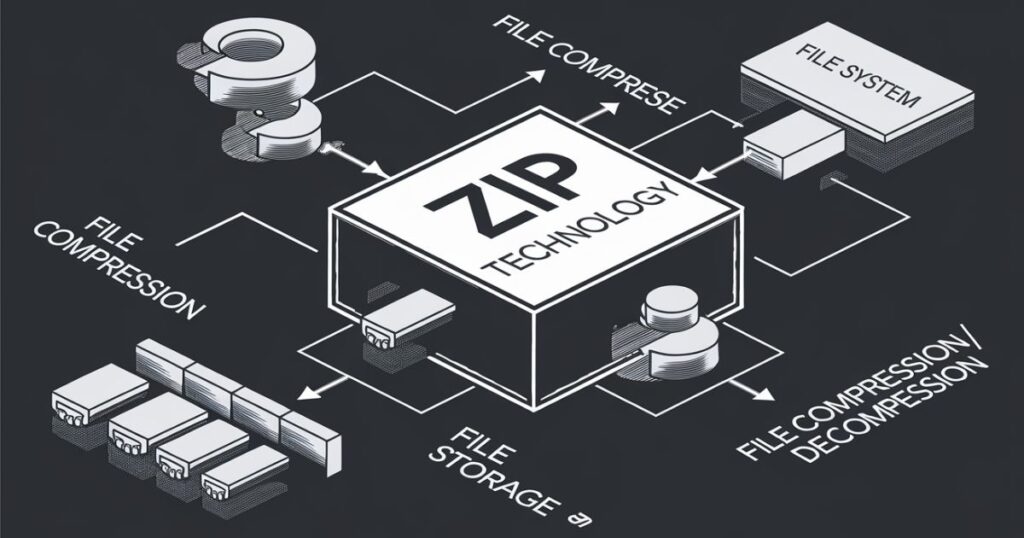Introduction to ZIP Up Technology
In today’s fast-paced digital world, file compression and storage solutions have become increasingly important for both personal and professional use.
ZIP up technology represents one of the most fundamental and widely-used methods for compressing and archiving files.
This comprehensive guide explores the intricate details of ZIP technology, its evolution, and its crucial role in modern computing.
Understanding the Basics of ZIP Technology
What is ZIP Compression?
ZIP compression is a data compression and file packaging technology that reduces the size of files by eliminating redundant data and combining multiple files into a single container.
The technology was first introduced by Phil Katz in 1989 and has since become the de facto standard for file compression.
When files are “zipped up,” they undergo a sophisticated process of analysis and compression that maintains data integrity while significantly reducing storage requirements.
How ZIP Compression Works
The fundamental principle behind ZIP compression involves complex algorithms that identify and eliminate redundant patterns in data.
The process employs both lossless compression techniques and dictionary coding methods. During compression, the system creates a reference dictionary of repeated patterns, replacing them with shorter codes while ensuring that the original data can be perfectly reconstructed during decompression.
Technical Aspects of ZIP Technology

Compression Algorithms
At its core, ZIP technology utilizes several compression algorithms, with DEFLATE being the most common. This algorithm combines two compression methods: LZ77 (Lempel-Ziv 1977) and Huffman coding.
The LZ77 algorithm identifies and records repeated strings within the data, while Huffman coding assigns shorter codes to frequently occurring characters and longer codes to less frequent ones.
File Format Structure
The ZIP file format consists of several key components:
- Local file headers containing metadata
- Compressed data streams
- Central directory records
- End of central directory record
Each component plays a crucial role in organizing and maintaining the integrity of compressed data, ensuring efficient storage and retrieval of files.
Applications and Uses
Enterprise Applications
In the business world, ZIP technology serves multiple critical functions. Organizations utilize ZIP compression for data backup, file transfer, and storage optimization.
The technology enables efficient email attachment handling, reduces storage costs, and facilitates faster file transfers across networks.
Large enterprises particularly benefit from ZIP technology when managing vast amounts of data across multiple locations and systems.
Personal Computing
For individual users, ZIP technology provides practical solutions for everyday computing needs. From organizing personal files to sharing photos and documents, ZIP compression helps manage digital content effectively.
The technology’s universal compatibility across different operating systems makes it an invaluable tool for personal file management and sharing.
Read This Post: Technology Questions
Advanced Features of ZIP Technology

Encryption and Security
Modern ZIP technology incorporates robust security features, including AES encryption (Advanced Encryption Standard).
This provides users with military-grade protection for sensitive data. The encryption capabilities allow for:
- Password protection of compressed files
- Different encryption strength levels
- Secure file sharing options
Multi-Volume Archives
ZIP technology supports the creation of split or multi-volume archives, allowing large compressed files to be divided into smaller, manageable segments.
This feature proves particularly useful when dealing with storage media limitations or when transferring large files across networks with size restrictions.
Evolution and Future Trends
Historical Development
The evolution of ZIP technology spans several decades, marked by significant improvements in compression efficiency and security features.
From its inception in the late 1980s to modern implementations, ZIP technology has continuously adapted to meet changing technological needs and security requirements.
Modern Innovations
Recent developments in ZIP technology focus on enhancing compression ratios, processing speed, and security features. These innovations include:
- Integration with cloud storage solutions
- Enhanced encryption methods
- Improved compression algorithms
- Support for larger file sizes
Integration with Modern Systems
Cloud Computing Integration
The integration of ZIP technology with cloud computing platforms has revolutionized file storage and sharing. Modern cloud services automatically implement ZIP compression to optimize storage space and transfer speeds. This seamless integration ensures efficient data management while maintaining accessibility and security.
Mobile Device Support
As mobile computing continues to dominate the technological landscape, ZIP technology has adapted to support mobile platforms effectively.
Modern smartphones and tablets include built-in support for handling ZIP files, enabling users to manage compressed files directly from their mobile devices.
Best Practices and Optimization
Compression Efficiency
To maximize the benefits of ZIP technology, understanding optimal compression settings is crucial. Factors affecting compression efficiency include:
- File type considerations
- Compression level selection
- Archive size management
- Resource utilization balance
Performance Considerations
When implementing ZIP technology, several performance factors require attention. This includes balancing compression ratios with processing time, managing system resources effectively, and choosing appropriate compression levels based on specific use cases.
Troubleshooting and Maintenance
Common Issues
Users may encounter various challenges when working with ZIP technology, including corrupt archives, incomplete extractions, or encryption issues.
Understanding common problems and their solutions ensures smooth operation and reliable file management.
Maintenance Guidelines
Regular maintenance of ZIP archives helps prevent data corruption and ensures long-term accessibility.
This includes periodic testing of archived files, updating encryption methods, and maintaining backup copies of important compressed data.
Industry Standards and Compatibility
Cross-Platform Support
ZIP technology’s widespread adoption has led to extensive cross-platform support. Modern operating systems include native support for ZIP files, ensuring seamless file sharing and management across different platforms and devices.
Standardization Efforts
The development of industry standards for ZIP technology continues to evolve, with various organizations working to improve compatibility and implement new features while maintaining backward compatibility with existing systems.
Frequently Asked Questions About ZIP Up Technology
What is the maximum file size that can be compressed using ZIP technology?
The maximum file size for ZIP compression depends on the ZIP format version and the software being used.
The standard ZIP format (ZIP32) can handle individual files up to 4GB, while the more modern ZIP64 format supports file sizes up to 16 exabytes (theoretically).
However, practical limitations often depend on your system’s available memory and storage capacity.
Is ZIP compression completely lossless?
Yes, ZIP compression is entirely lossless, meaning no data is lost during the compression process.
When you decompress a ZIP file, you get back exactly the same data as the original file.
This is different from lossy compression methods used for images (JPEG) or audio (MP3) where some data is sacrificed to achieve smaller file sizes.
Can ZIP files be password protected, and how secure are they?
Yes, ZIP files can be password protected using various encryption methods. Modern ZIP software typically uses AES encryption (128-bit or 256-bit), which provides strong security.
However, the older ZIP 2.0 encryption standard is considered relatively weak by today’s standards and should be avoided for sensitive data.
Why do some files compress better than others?
Compression effectiveness varies depending on the file type and content. Text files, documents, and spreadsheets typically compress very well because they contain lots of repetitive data patterns.
However, already-compressed files like JPEGs, MP3s, or modern video formats usually show minimal improvement because they’ve already been compressed using specialized algorithms for their specific format.
Can damaged ZIP files be repaired?
In many cases, partially damaged ZIP files can be repaired using specialized recovery software.
Since ZIP files contain multiple components and a central directory, sometimes damaged portions can be reconstructed if the critical parts of the file structure remain intact.
However, success rates vary depending on the extent and location of the damage within the archive.
Conclusion
ZIP up technology remains a cornerstone of modern digital file management, combining efficient compression with robust security features.
As technology continues to advance, ZIP compression adapts and evolves, maintaining its relevance in an increasingly data-driven world.
Understanding and effectively utilizing ZIP technology is essential for both individual users and organizations seeking to optimize their digital resource management.
Through this comprehensive exploration of ZIP up technology, we’ve covered its fundamental principles, technical aspects, applications, and future trends.
As data storage and transfer requirements continue to grow, the importance of efficient compression technologies like ZIP will only increase, making it an invaluable tool in our digital toolkit.
Vividcrest admin brings expert insights in Tech and Gaming, offering up-to-date content, in-depth analysis, and trends to keep you ahead in the digital world.








